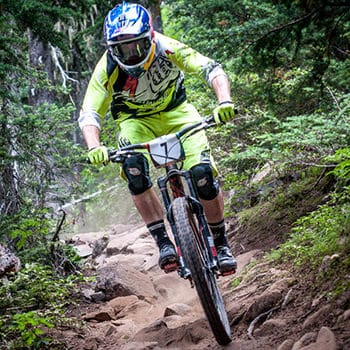Mountain Bike

Mountain biking is the sport of riding off-road over rough terrain on bikes that underscore durability and performance in rough terrain: wide, knobby tires, large frame tubing, front fork or dual suspension shock absorbers. The durability factor means a far heavier bicycle weight to rider ratio. Mountain biking is broken down into four categories: cross-country, downhill, four cross and trials.
This individual sport requires endurance, bike-handling skills and self-reliance. Most mountain bikers ride off-road trails, whether country back roads, fire roads, or singletrack (narrow trails that wind through forests, mountains, deserts, or fields). There are aspects of mountain biking is quite similar to trail running. Riders need to be self-reliant as they are often quite far away from civilization. Riders learn to repair their broken bikes or flat tires to avoid being stranded miles from help. Club rides and other forms of group rides are common.
Cycling Canada recently released their Mountain Bike (MTB) Long Term Athlete Development (LTAD) model. This document is a guide to mountain biking, based on principles of long-term athlete development, and informed by their work on Gold Medal Profile for MTB. LTAD is a pathway for optimal training, competition and recovery throughout an athlete’s career, but particularly in relation to the important growth and development years of young people.
For more information on mountain bike racing, including regulations regarding protective clothing, see the UCI mountain bike regulations.
Information
-
How to Start Mountain Biking
Getting started in any sport can sometimes be confusing. Here’s an article from naturesportcentral.com to help you with the basics on How to Start Mountain Biking
-
Trail Advocacy
There’s more to building a trail than moving rocks and dirt. Trails are usually part of larger systems that are the result of careful and diligent planning and collaboration. These trail systems must serve the needs of multiple user groups and take environmental and geographical factors into account.
While land managers and other administrators are ultimately responsible for land planning processes, committed trail users and community groups have important roles to play as well. Planning, after all, is ultimately about the big picture, and that picture includes not only the forest and the trees, but also the entire trails community.
Cycling BC advocates for the use of “Whistler Standards” outlined in Whistler Trail Standards: Environmental and Technical Trail Features.
-
Categories and Upgrades
If you hold a UCI International License, your Mountain Bike (XC or DH) ability category could be one of the following depending upon your age:
- Sport: Intermediate level riders
- Expert: Skilled amateur riders
- Pro-Elite: Professional level riders, who also have a UCI category of Under 23 or Elite
Riders without a UCI license in the last 5 years must register for the Novice category
Riders with a UCI license in the last 5 years must register with the category that they had on their last UCI license, unless they are applying for an upgrade.
Riders may apply to upgrade to the next highest ability level when they register for their license, or part way through the season. However, they cannot downgrade in the same season once you have upgraded. Riders must have held a UCI license in the last season to be eligible for an upgrade.
